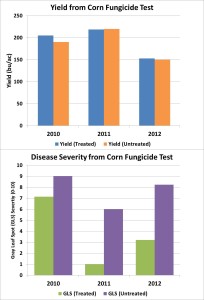Over the past couple of seasons more fungicide applications have been marketed for application at early vegetative growth stages in corn (V5-V6 growth stages). Based on the majority of university research data…
An early application of fungicide in corn has been inconsistent in significantly increasing yield compared to untreated corn. The main purpose of applying a fungicide is for the management of fungal diseases and at V5-V6 there are few to no diseases present. Anthracnose leaf blight may be present at an early vegetative growth stage, but often does not need management due to rapid corn growth and warm temperatures. Such an early application is also unlikely to provide any protection from late season diseases such as gray leaf spot or northern leaf blight. An article by Dr. Carl Bradley of U of I, Does Early-Stage Corn Need a Fungicide Application?, provides more information on these topics and others.
Physiological benefits from early fungicide applications in corn have been discussed over that past couple of seasons also. One physiological benefit in particular is preventing greensnap. Greensnap is referring to corn stalks that are completely broken off below the area where the developing ear emerges. Greensnap can occur more often in certain hybrids that have ‘brittle stalks’ or in any hybrid if a major wind event occurs prior to ear formation (pre-VT), following a period of rapid growth. Dr. Tom Allen of MSU, reported (in Are Early, Vegetative Fungicide Applications Beneficial for Enhanced Corn Production? (Part II: Impact of Fungicide on Greensnap) the results from a 2012 trial located west of Greenwood, MS where a major straight line wind event occurred and did result in severe greensnap – creating an ideal situation to report on early fungicide application effect on greensnap. Based on that trial, which had 7 different fungicides applied at V6 on Pioneer 1187, a hybrid reported to have a brittle stalk, fungicides, regardless of active ingredient (strobilurin; strobilurin + triazole; or triazole) did not consistently reduce percent greensnap compared to untreated control.
The fungicide timing that provides the most consistent yield increase over untreated corn yields is at VT or R1 growth stage (tasseling to pollination) when disease is present or there is significant risk of disease. University of Tennessee research data from 2010 through 2012 (graph – Yield from Foliar Fungicide Test), collected by Dr. Melvin Newman on different fungicides applied at VT (tasseling) reported only a significant, 15 bu/a increase in yield over untreated corn in 2010. This increase is most likely due to the greater disease pressure in that year (graph – Disease Severity from Corn Fungicide Test). Similar results were reported in another article by Dr. Bradley (Target Diseases When Considering Foliar Fungicides for Corn) which clearly revealed the critical role disease pressure plays in the magnitude and consistency of yield response to a foliar fungicide application in corn.



Considering all of the excessive rain we have had this spring, do we have a better set-up for a positive response to foliar fungicide in corn applied at R1? Three thoughts: 1.) The weather has been chronically wet and cool all spring. In my continuous no-till, wouldn’t this provide an ideal environment for fungal development on the in-field residue? 2.) The excessive rain has probably caused a significant amount of fertilizer to leach out. Since the first line of defense for a healthy plant is adequate fertilizer would the corn be unusually vulnerable to disease infection? 3.) I planted some corn on corn this year. Wouldn’t those acres be particularly susceptible to disease development when considering my first two points? Thanks for your help.
Richard,
Thank you for the questions. A positive response to a foliar fungicide at R1 will depend on a couple factors: the hybrid planted (considering the disease resistance it has or lack of), environmental conditions closer to R1, but leading up to it, field history (continuous corn will increase risk of disease development) and what disease pressure is in the area and in that particular field. Addressing your other comments/questions – (1) The wet and cool weather we have received this spring is conducive for seedling diseases, but most should be suppressed by good seed treatments containing a fungicide. For disease to develop on the residue moisture has not been a limiting factor, but continued rainy weather into the season is something that will be a major determining factor as well as temperature – it’s too soon to make a prediction about the weather closer to the VT-R1 growth stage which will have more influence on disease development at that time. (2) As for the fertilizer, you can supplement nitrogen if needed, but the potassium and phosphorus should still be good. Over fertilization can increase disease risk just as much as, if not more than under fertilization. (3) Corn on corn will have an increased risk of disease development. Knowing the disease resistance or lack of it in the hybrid planted, scouting the field for disease leading up to VT-R1, and monitoring the weather will give you a better gauge on a response to a fungicide application at VT-R1 this season. Thanks again for your questions.
Best Regards,
Heather